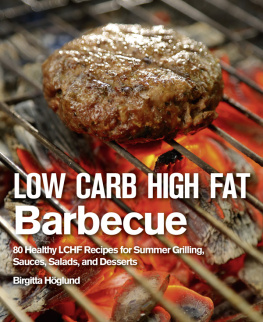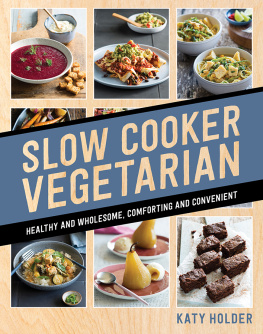Copyright 2015 by Birgitta Hglund
English translation copyright 2015 by Skyhorse Publishing
Originally published as Lngkok fr LCHF och Paleo 2013 by Pagina Frlags AB/Optimal Frlag
All rights reserved. No part of this book may be reproduced in any manner without the express written consent of the publisher, except in the case of brief excerpts in critical reviews or articles. All inquiries should be addressed to Skyhorse Publishing, 307 West 36th Street, 11th Floor, New York, NY 10018.
Skyhorse Publishing books may be purchased in bulk at special discounts for sales promotion, corporate gifts, fund-raising, or educational purposes. Special editions can also be created to specifications. For details, contact the Special Sales Department, Skyhorse Publishing, 307 West 36th Street, 11th Floor, New York, NY 10018 or .
Skyhorse and Skyhorse Publishing are registered trademarks of Skyhorse Publishing, Inc., a Delaware corporation.
Visit our website at www.skyhorsepublishing.com.
10 9 8 7 6 5 4 3 2 1
Library of Congress Cataloging-in-Publication Data is available on file.
Cover photo credit: Mikael Eriksson
Interior design and photos: Mikael Eriksson, M Industries
Print ISBN: 978-1-63220-531-5
Ebook ISBN: 978-1-63220-932-0
Printed in China
CONTENTS
Foreword by Ann Fernholm
Daddy, Daddycan I play with the tail? The father quickly chops off the tail and throws it to his six-year-old child, who, along with a friend, happily starts playing with it. They whisk the red dirt, trailing the tails end like a brush. The father continues to remove the hide and cut up the cow. His work must be done quicklyits hot outside and the meat will start to go bad quickly. He cuts off the branded ear and tosses it into the bush. No one will be any the wiser as to who owned this dead animal. Its the neighbors cow, which strayed onto the Hayfield Shenandoah Cattle station land. This means the meat is free, even though more than 20,000 head of cattle graze on this land. The workers eat beefsteak for breakfast.
This memory from the wide expanses of Northern Australia comes to me as I stand in the meat department of a food market in Stockholm (Sweden) some thirty years later. The assistant has just pulled out a packet of oxtail from the freezer. The tail is cut into eight pieces; its very clear that this is a tail, because the pieces become progressively thinner as they move away from the base. I chuckle. In my freezer youll see mostly chicken breasts and salmon filets. I have never bought oxtail. The meat is marbled with fat, and in the middle is the tailbone. I think to myself: this is the beginning of something new, and walk home. These are the first steps toward undertaking something Ive promised myselfnamely, to explore new flavors.
Cut Down on Sugar and Discover a Whole New World
All the recipes within this book contain very few carbohydrates, and Birgitta Hglund doesnt skimp on the fat. Since I began eating according to low-carb guidelines, I have taken an interest in noticing how my taste for different foods has changed. After only about a year, Im not as tempted by sweet rolls and cookies as I used to bethey simply dont taste that great anymore. Theyre too sweet. Things I used to love to eat have now become sort of underwhelming. On the flip side, other tastes have taken over; spices have somehow blossomed in magnitude and diversity.
Becoming aware that fatty food has little bearing on weight gain or on the increased risk of heart attack has gone a long way toward heightening my enjoyment of cooking. Before, each calorie led me to suffering a guilty conscience. Now I enjoy each mouthful of food, and feel good about it. Food is far more flavorful when I dont have to be sparing in my use of fat, so I willingly trade sweet rolls for cream sauces. This knowledge has brought on a renewed enthusiasm for cooking and spices; consequently, I was more than happy to help out when I was asked to write the foreword to this cookbook. This is the starting point to a new adventure: to learn how to slow-cook. I want to discover new foods, new spices, and new ingredientssuch as oxtail.
Slow cooking requires sturdy pots, howevernot your everyday cookware. My husband found a cast-iron Dutch oven from Skeppshults, the famous old Swedish foundry, in a thrift store, for about $53. It was in this pot that I browned the onions and garlic, the first step to Birgitta Hglunds Oxtail Stifado.
Once the tomato pure began to simmer with the onion, the first heady aromas wafted up from the pot. The orange, cinnamon, cloves, and bay leaves followeda beguiling treat for the nose. I browned the chunks of oxtail in another pan, before combining everything in the cast-iron pot. All the spices simmered and blended together while cooking in the oven over a period of eight hours. The ovens temperature: 212F (100C).
That evening, there was a certain French quality to the air as I dished out the finished stew: its dark color, tender meat, and flavorful seasonings all made it look like a Christmassy buf bourguignon. I asked my children to describe their first impressions. Gingerbread, but with real ginger, answered my six-year-old son. My daughter, who enjoyed the stew immensely, picked up on the subtle notes of orange, and the cinnamon. Oxtail Stifado became even more interesting when I mixed the stew with some of the recommended mint-flavored yogurt. The flavors became more nuanced and landed gently on the tongue: first the orange, then the clove and cinnamon, and lastly, the full-bodied flavor of the meat. Paired with some red wine, it became a meal to appease the soul.
FatThe Newly Discovered Sixth Taste Area on our Tongues
We might be able to attribute some of the feeling of calm we experience after eating tasty and fatty foods to newly discovered receptors on our taste buds that react specifically to fat. We learned in biology class that our tongue is able to distinguish between four basic tastes: sweet, salty, sour, and bitter. Later, scientists found that we are also capable of tasting the amino acid glutamate, which is a part of protein-rich foods. This taste is called umami , from the Japanese word for good taste.
This is nowhere near the end of the story on our perception of taste, however. Fat hasnt got a flavor per se, which is why scientists think it might be erroneous to call those new receptors on the tongue taste buds. They make us very aware that it is fat were tasting in the foodtheyre akin to a small recorder. When we put something fatty in our mouth, the receptors ensure that the nerve signal is sent to the brain. Scientific research shows that both dopamine and endorphins are released; these neurotransmitters make our body feel calm and relaxed.
When Im enjoying a bowl of Oxtail Stifado, Im sure this is what happens. The endorphins travel out into the bloodstreamI can feel it. Suddenly I realize that as Im eating, Im slowing down. The body is beginning to feel that it has had enough food.
Fat Makes You Feel Satiated for Extended Periods of Time
By this time the oxtail has been absorbed in the stomach, and several other hormones are on their way out into the bloodstream. There are several molecules that influence the point at which we feel full: leptin, ghrelin, peptid YY, glucagon-like peptide-1, and cholecystokinin. You dont need to try to remember all these; I simply mention them to illustrate the fact that the body takes feelings of satiety very seriously.














